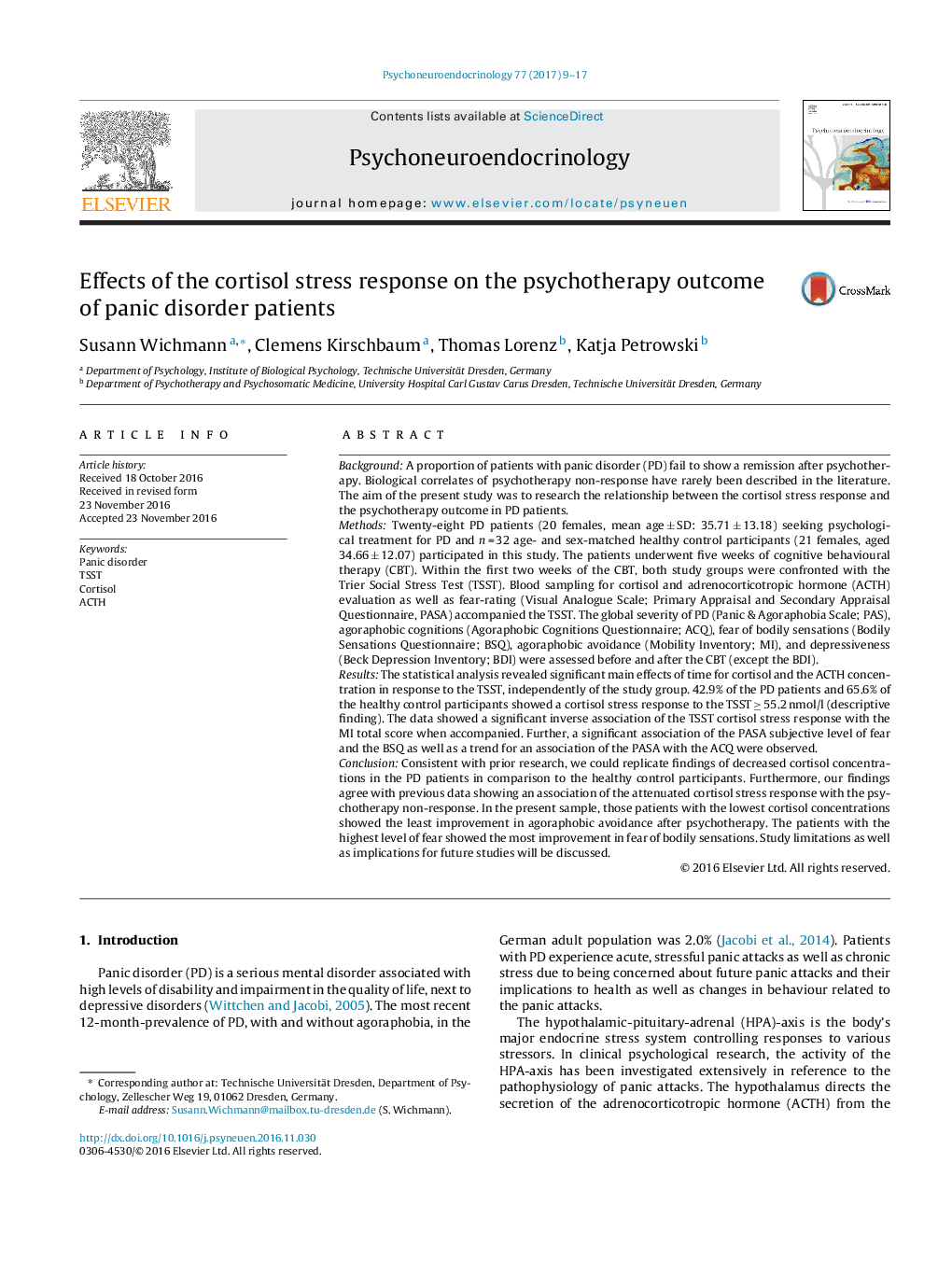| کد مقاله | کد نشریه | سال انتشار | مقاله انگلیسی | نسخه تمام متن |
|---|---|---|---|---|
| 4934538 | 1433966 | 2017 | 9 صفحه PDF | دانلود رایگان |
- Relationship between cortisol stress response and psychotherapy outcome in panic disorder patients.
- Standardized manual-based cognitive behavioural therapy implemented.
- Cortisol stress response is inversely associated with agoraphobic avoidance after psychotherapy.
- Subjective level of fear is positively associated with fear of bodily sensations after psychotherapy.
- Potential impact of comorbid depression on the cortisol stress response in panic disorder patients.
BackgroundA proportion of patients with panic disorder (PD) fail to show a remission after psychotherapy. Biological correlates of psychotherapy non-response have rarely been described in the literature. The aim of the present study was to research the relationship between the cortisol stress response and the psychotherapy outcome in PD patients.MethodsTwenty-eight PD patients (20 females, mean age ± SD: 35.71 ± 13.18) seeking psychological treatment for PD and n = 32 age- and sex-matched healthy control participants (21 females, aged 34.66 ± 12.07) participated in this study. The patients underwent five weeks of cognitive behavioural therapy (CBT). Within the first two weeks of the CBT, both study groups were confronted with the Trier Social Stress Test (TSST). Blood sampling for cortisol and adrenocorticotropic hormone (ACTH) evaluation as well as fear-rating (Visual Analogue Scale; Primary Appraisal and Secondary Appraisal Questionnaire, PASA) accompanied the TSST. The global severity of PD (Panic & Agoraphobia Scale; PAS), agoraphobic cognitions (Agoraphobic Cognitions Questionnaire; ACQ), fear of bodily sensations (Bodily Sensations Questionnaire; BSQ), agoraphobic avoidance (Mobility Inventory; MI), and depressiveness (Beck Depression Inventory; BDI) were assessed before and after the CBT (except the BDI).ResultsThe statistical analysis revealed significant main effects of time for cortisol and the ACTH concentration in response to the TSST, independently of the study group. 42.9% of the PD patients and 65.6% of the healthy control participants showed a cortisol stress response to the TSST â¥Â 55.2 nmol/l (descriptive finding). The data showed a significant inverse association of the TSST cortisol stress response with the MI total score when accompanied. Further, a significant association of the PASA subjective level of fear and the BSQ as well as a trend for an association of the PASA with the ACQ were observed.ConclusionConsistent with prior research, we could replicate findings of decreased cortisol concentrations in the PD patients in comparison to the healthy control participants. Furthermore, our findings agree with previous data showing an association of the attenuated cortisol stress response with the psychotherapy non-response. In the present sample, those patients with the lowest cortisol concentrations showed the least improvement in agoraphobic avoidance after psychotherapy. The patients with the highest level of fear showed the most improvement in fear of bodily sensations. Study limitations as well as implications for future studies will be discussed.
Journal: Psychoneuroendocrinology - Volume 77, March 2017, Pages 9-17
